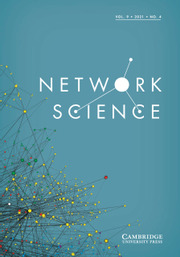Crossref Citations
This article has been cited by the following publications. This list is generated based on data provided by
Crossref.
Durante, Daniele
Dunson, David B.
and
Vogelstein, Joshua T.
2017.
Rejoinder: Nonparametric Bayes Modeling of Populations of Networks.
Journal of the American Statistical Association,
Vol. 112,
Issue. 520,
p.
1547.
Raftery, Adrian E.
2017.
Comment: Extending the Latent Position Model for Networks.
Journal of the American Statistical Association,
Vol. 112,
Issue. 520,
p.
1531.
Garrod, Matthew
and
Jones, Nick S.
2018.
Large algebraic connectivity fluctuations in spatial network ensembles imply a predictive advantage from node location information.
Physical Review E,
Vol. 98,
Issue. 5,
Penrose, Mathew D.
2018.
Inhomogeneous random graphs, isolated vertices, and Poisson approximation.
Journal of Applied Probability,
Vol. 55,
Issue. 1,
p.
112.
Kim, Bomin
Lee, Kevin H.
Xue, Lingzhou
and
Niu, Xiaoyue
2018.
A review of dynamic network models with latent variables.
Statistics Surveys,
Vol. 12,
Issue. none,
Jin, Ick Hoon
and
Jeon, Minjeong
2019.
A Doubly Latent Space Joint Model for Local Item and Person Dependence in the Analysis of Item Response Data.
Psychometrika,
Vol. 84,
Issue. 1,
p.
236.
Haghani, Sogol
and
Keyvanpour, Mohammad Reza
2019.
A systemic analysis of link prediction in social network.
Artificial Intelligence Review,
Vol. 52,
Issue. 3,
p.
1961.
Nam, Jin Hyun
Yun, Jonghyun
Jin, Ick Hoon
and
Chung, Dongjun
2020.
hubViz: A novel tool for hub-centric visualization.
Chemometrics and Intelligent Laboratory Systems,
Vol. 203,
Issue. ,
p.
104071.
Sweet, Tracy
and
Adhikari, Samrachana
2020.
A Latent Space Network Model for Social Influence.
Psychometrika,
Vol. 85,
Issue. 2,
p.
251.
Gollini, Isabella
Caimo, Alberto
and
Campana, Paolo
2020.
Modelling interactions among offenders: A latent space approach for interdependent ego-networks.
Social Networks,
Vol. 63,
Issue. ,
p.
134.
Dabbs, Beau
Adhikari, Samrachana
and
Sweet, Tracy
2020.
Conditionally Independent Dyads (CID) network models: A latent variable approach to statistical social network analysis.
Social Networks,
Vol. 63,
Issue. ,
p.
122.
Schweinberger, Michael
Krivitsky, Pavel N.
Butts, Carter T.
and
Stewart, Jonathan R.
2020.
Exponential-Family Models of Random Graphs: Inference in Finite, Super and Infinite Population Scenarios.
Statistical Science,
Vol. 35,
Issue. 4,
Hoff, Peter
2021.
Additive and Multiplicative Effects Network Models.
Statistical Science,
Vol. 36,
Issue. 1,
Tafakori, Laleh
Pourkhanali, Armin
and
Rastelli, Riccardo
2022.
Measuring systemic risk and contagion in the European financial network.
Empirical Economics,
Vol. 63,
Issue. 1,
p.
345.
Spencer, Neil A.
Junker, Brian W.
and
Sweet, Tracy M.
2022.
Faster MCMC for Gaussian latent position network models.
Network Science,
Vol. 10,
Issue. 1,
p.
20.
Vladimirova, Alina V.
2022.
In search of soft power: mapping the expert community with a bibliometric network analysis.
Journal of Political Power,
Vol. 15,
Issue. 3,
p.
556.
Schweinberger, Michael
Bomiriya, Rashmi P.
and
Babkin, Sergii
2022.
A semiparametric Bayesian approach to epidemics, with application to the spread of the coronavirus MERS in South Korea in 2015.
Journal of Nonparametric Statistics,
Vol. 34,
Issue. 3,
p.
628.
Dizon-Ross, Rebecca
and
Ross, Sheldon M.
2022.
A PROBABILISTIC FRIENDSHIP NETWORK MODEL.
Probability in the Engineering and Informational Sciences,
Vol. 36,
Issue. 1,
p.
1.
Rastelli, Riccardo
and
Corneli, Marco
2023.
Continuous latent position models for instantaneous interactions.
Network Science,
Vol. 11,
Issue. 4,
p.
560.
Park, Jina
Jin, Ick Hoon
and
Jeon, Minjeong
2023.
How Social Networks Influence Human Behavior: An Integrated Latent Space Approach for Differential Social Influence.
Psychometrika,
Vol. 88,
Issue. 4,
p.
1529.

